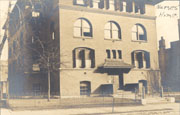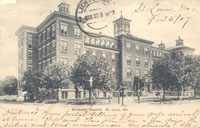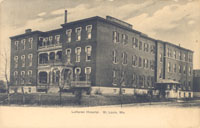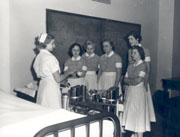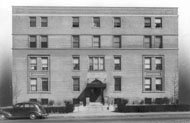Health Professions
The Early History of Nursing Schools in St. Louis
A total of 24 training schools for nurses were established in Missouri during the latter decades of the 19th century. In addition to the 15 St. Louis schools listed below, 7 were founded in Kansas City and 2 in St. Joseph. By 1911, 47 nurse training schools were operating in Missouri, including 2 collegiate schools of nursing (the University of Missouri and Washington University). By 1921 the establishment of regulatory laws and standards both diminished the rate of increase of new schools and caused some schools, whose foundations were not substantial, to close. The economic pressures of the Depression further reduced the number of nurse training schools, forcing the closing of 16 training schools in Missouri.
The 19th Century
Only 10 years after the first school of nursing was established in the United States, a group of 20 educational, medical, legal and civic leaders in St. Louis convened an organizational meeting on December 7, 1883, establishing the St. Louis Training School for Nurses. The eight woman executive committee chose Mrs. William H. Pulsifer, a non-practicing physician, as president of the organization. Mrs. Pulsifer had investigated conditions at the City Hospital regarding the care of the city’s sick, poor residents and was instrumental in interesting others in establishing a school of nursing.
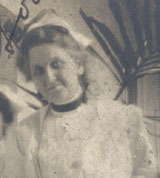 |
| Miss Emma L. Warr |
The school opened in the spring of 1884 and was based at the St. Louis City Hospital. Students received a small monthly allowance from the city in return for working 12-hour days on the wards and attending lectures. The two-year course of study was under the direction of Miss Emma L. Warr, a graduate of the New York Hospital School of Nursing. The first class of four students graduated in April 1886. By 1891 almost all of the St. Louis City Hospital’s nursing service supervision was provided by St. Louis Training School for Nurses graduates and students.
The St. Louis Training School for Nurses, in association with the St. Louis Provident Association, began the first visiting nurse program in the city in the autumn of 1895. Miss Elizabeth Brown, a graduate of the Training School, was the city’s first “district nurse.” Street-cars, and later a horse and buggy, transported the visiting nurses to the homes of the sick poor. The visiting nurses carried with them clean linen and a wash basin. The St. Louis Training School for Nurses may also be credited with the first informal courses in public nursing, as student nurses were assigned to assist the visiting nurses.
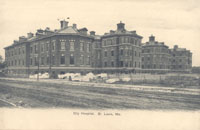 |
| St. Louis City Hospital, ca. 1910 |
In 1895 Miss Warr requested that the course of study be extended to three years, but before any action had been taken, a tornado that swept through St. Louis on May 27, 1896 demolished the City Hospital. The curriculum was changed when the City Hospital was rebuilt and reopened in 1905. In 1915 the City of St. Louis Board of Alderman passed an ordinance providing for a municipal training school for nurses. In July of that year the St. Louis Training School for Nurses was transferred to the city and renamed the St. Louis City Hospital Training School for Nurses.
By the end of the 19th century, several more training schools for nurses had opened in St. Louis.
St. Luke’s Hospital, established in 1865, began a training school for nurses in 1889. Under the supervision of Mrs. Mary J. Chambers, superintendent of the nurses at the hospital, the St. Luke’s Training School for Nurses enrolled its first class in March 1889. Seven students received diplomas in May 1892. The initial curriculum combined classroom instruction in the nursing arts and basic sciences with lectures given by the medical staff. In 1891 the school was made a permanent department of the hospital; by 1901 the course of study was expanded to three years.
The Protestant Hospital Training School for Nurses opened in October 1890, offering an eighteen-month course of study. The school, under superintendent of nurses, Miss Josephine B. Rice, closed in 1900. The Protestant Hospital itself closed in 1909.
The Evangelical Deaconess Hospital opened in August 1889 in an 11-room house, with a staff of four doctors and two deaconesses, Mrs. Katherine Haack and her adopted daughter Miss Lydia Daries. The School for Deaconess Nurses opened in 1891 and trained deaconess nurses only. Nursing education was of the apprenticeship type. Younger deaconesses learned to care for patients by following the instructions of older deaconesses. Lectures on anatomy and physiology were given twice a week by a physician. Though the hospital prospered and grew, the nursing school was slow in producing graduates. The first graduate was Sister Magdalene Gerhold in 1893. The next graduate was not consecrated until 1902. The school began to prosper during the early years of the 20th century, training Deaconess sisters who worked both in hospitals and as missionaries. In 1931 the institution became the Deaconess Hospital School of Nursing. The school began admitting lay students in 1943. Now known as the Deaconess College of Nursing, the institution now offers both a bachelor’s and associate’s degree in nursing.
The St. Louis Baptist Hospital Training School for Nurses opened in 1893 with a two-year course of training. The curriculum was expanded to three years in 1903, in keeping with the trend toward higher standards elsewhere. The St. Louis Baptist Hospital became a commercial enterprise in the early 1920s and the name changed to the Central Hospital. The Central Hospital Training School for Nurses continued until a last class was admitted in 1929, graduating in 1932.
The Rebekah Hospital and Rebekah Hospital Training School for Nurses opened concurrently in January 1893. In 1895 the Marion-Sims Medical College assumed control of the Rebekah Hospital Training School. Seventeen women were graduated from the Training School before its closing around the turn of the century.
The Women’s Hospital and the Women’s Hospital Training School for Nurses opened concurrently in 1894. The school was intended solely to provide training for its own personnel.
The Sisters of Charity founded the Mullanphy Hospital Training School for Nurses in 1894, offering a two-year course of instruction. The first students were on 24-hour duty, seven days a week, and quartered in the wards. The program was expanded to three years in 1900. By then students had their own quarters and duty was reduced to 12-hours per day, seven days a week.
The Missouri Baptist Sanitarium Training School for Nurses was organized in October 1895 and graduated its first four students in April 1897. Miss Sarah Whelpton, a graduate of the St. Louis Training School for Nurses, was appointed superintendent of nurses of the Sanitarium and given the task of organizing the training school.
The Mayfield Sanitarium Training School for Nurses began its program in 1896, though the first six graduates did not receive their diplomas until 1901. A total of 103 women graduated from the school before its closing in 1919.
The Bethesda Hospital and the Bethesda Hospital Training School for Nurses were incorporated in 1896. Miss Alice Funk, the first to enroll in the school and one of the first group of graduates, served as the first superintendent of the school. From 1898 until 1933 when the last class was graduated, a total of 178 nurses received diplomas from the school.
The Lutheran Hospital, founded in 1858, established a training school for nurses in 1898. The Lutheran Hospital Training School for Nurses was under the direction of Mrs. Louise Krauss, a graduate of the Rebekah Hospital Training School for Nurses. Mrs. Krauss served as director from 1898 until 1904, from 1908 to 1909, and finally from 1919 until 1933.
Provident Hospital, a small facility run by African-American physicians for their patients, opened a training program for African American nurses in 1899. Missouri’s first training school for African-American nurses, the Provident Hospital Training School for Nurses, offered a two-year course of instruction, with lectures provided by the hospital’s medical and consulting staff.
St. Anthony’s Hospital and its nurses’ training school were established by a group of Franciscan Sisters in 1900. The St. Anthony’s Hospital Training School for Nurses trained only religious sisters; the last class graduated in 1929. Few of the 83 graduates took the Missouri state board examinations, principally because obstetrics was neither included in the curriculum nor allowed in the training experience.
The year 1900 also saw the opening of the Centenary Hospital and the Centenary Hospital Training School for Nurses. Miss M. E. Hainsworth, a graduate of the St. Luke’s Hospital Training School for Nurses, was the principal of the school. Eight classes were graduated before the hospital and training school closed in 1911.
The 20th Century
The new century saw the establishment of not only more hospital-based schools of nursing but also the first collegiate schools of nursing in St. Louis and Missouri. The more successful hospital schools included the Jewish Hospital of St. Louis, St. John’s Hospital, St. Mary’s Hospital, and Homer G. Phillips Hospital. The University of Missouri established a three-year training school for nurses in 1901. Washington University opened its training school in 1905. In 1928 the St. Louis University School of Nursing was organized.
The Jewish Hospital Training School for Nurses opened in 1902. The three-year diploma school graduated its first class in 1905. In 1925 the name was changed to the Jewish Hospital School of Nursing. The three-year diploma program was replaced with a degree program in 1993 when the school was reorganized as the Jewish Hospital College of Nursing and Allied Health.
The Sisters of Mercy’s St. John’s Hospital, established in 1871, affiliated with the St. Louis University School of Medicine in 1903. Two years later the St. John’s Hospital Training School for Nurses was established with instruction provided by the medical staff and graduate lay nurse instructors. In 1928 the St. John’s Hospital School of Nursing joined St. Mary’s Hospital and Alexian Brothers Hospital as units of the St. Louis University School of Nursing. St. John’s discontinued its association with St. Louis University in 1937. The Alexian Brothers Hospital School of Nursing admitted only members of the Congregation of Alexian Brothers, the oldest order of men engaged in hospital work in the Roman Catholic Church. The school was short-lived – the school was accredited in 1928, separated from St. Louis University in 1934, and graduated its last students in 1952.
St. Mary’s Infirmary School of Nursing opened with a three-year program in 1907 and at first offered instruction to the religious sisters (Sisters of St. Mary, the founders of the hospital) only. The school was opened to lay students in 1928. In 1933, the hospital and school were rededicated to the service of African-American patients and was entirely staffed by black doctors and nurses, excepting the Sisters themselves. The school admitted only African-American women until the mid-1950s. At that time the administrators of the school thought it better to close the school that to convert to a non-segregated institution. The school closed after the graduation of the class of 1958.
The St. Louis University School of Nursing was organized in 1928 with the integration of the existing schools of nursing at St. John’s Hospital and St. Mary’s Hospital with the founding a new school of nursing at the Alexian Brothers Hospital. The educational policy and administration of the three schools was placed under the authority of the University. A curriculum leading to a bachelor of science degree in nursing began in 1937, while the three-year certificate program was discontinued in 1939. By 1935 the school was known as the School of Nursing and Allied Health Professions, with a division of Nursing and a division of Health and Hospital Services. Each division became a separate school of the university in 1979.
The Homer G. Phillips Hospital opened in February 1937 as the successor to the St. Louis City Hospital No. 2 for Colored, which had opened in 1919. Until it was reclassified as a racially integrated institution in 1954, Homer G. Phillips Hospital was the world’s largest exclusively black municipally operated general hospital. The first graduates of the St. Louis City Hospital No. 2 School of Nursing were Miss Bessie Newsome Miss Beatrice Wilkerson, Miss Agnes Smith, and Miss Beatrice Hinch who were registered to practice nursing in 1922. In 1940 Mrs. Estelle Massey Riddle Osborne became the hospital’s first African-American superintendent of nurses. Beginning with the class of 1955, the Homer G. Phillips Hospital School of Nursing was desegregated. The Nursing School graduated its last class in 1968; the hospital closed in 1979.
A latecomer to the field of hospital-sponsored schools of nursing was Barnes Hospital. The Barnes Hospital School of Nursing began its three-year diploma program in 1955. In 1989 the Hospital restyled its nursing programs, phasing out the diploma program of the School of Nursing and offering a four-year bachelor’s degree through the newly launched Barnes College of Nursing. In 1994, the Barnes College of Nursing merged with the University of Missouri-St. Louis, which at the time offered a program for registered nurses seeking bachelor’s, master’s and doctoral degrees. The merged school, the Barnes College of Nursing at the University of Missouri – St. Louis, joined St. Louis University, Maryville University, and Deaconess College of Nursing in offering bachelor’s degrees in nursing in St. Louis.
Less successful schools of nursing in St. Louis in the early 20th century included:
The Josephine Heitkamp Hospital Nurse Training School was open from 1908 to 1932, a victim both of the Depression and problems with maintaining state accreditation. Another victim of the Depression was the Christian Hospital Training School for Nurses. The first graduate received her diploma in 1909; the last class was graduated in 1935. The People’s Hospital Training School for Negro Nurses opened in 1919 and was plagued by inadequate facilities and accreditation woes during its 9 years of operation.
Financial difficulties also affected the Liberty Hospital Training School for Nurses, which opened in 1921 with Miss Suzie Frazier, a graduate of the St. Louis Baptist Hospital Training School for Nurses, as principal. The hospital was reorganized and renamed Crenshaw General Hospital in 1926. The nursing school became known as the Crenshaw General Hospital Training School for Nurses, but closed in 1927 when the hospital passed into the hands of a receiver.
The Missouri Pacific Hospital Training School for Nurses admitted 15 students, all daughters of railroad employees, in the fall of 1923. Though affiliated with St. Louis City Hospital and St. Louis University, the training school closed within a year when it was realized that the home hospital did not provide the required clinical services.
Related Links:
Return to Nursing (Health Professions)
Return to Health Professions
Back to Top

